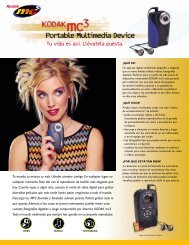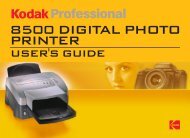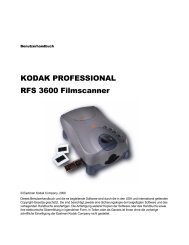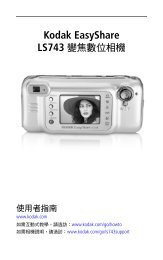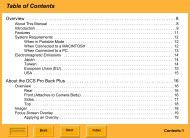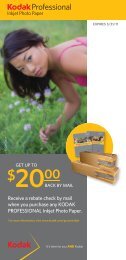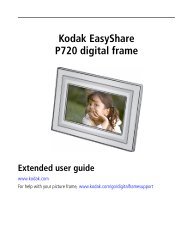KODAK EDGE Generations Paper
KODAK EDGE Generations Paper
KODAK EDGE Generations Paper
You also want an ePaper? Increase the reach of your titles
YUMPU automatically turns print PDFs into web optimized ePapers that Google loves.
TECHNICAL DATA / COLOR PAPER<br />
<strong>KODAK</strong> <strong>EDGE</strong> <strong>Generations</strong> <strong>Paper</strong><br />
<strong>KODAK</strong> <strong>EDGE</strong> <strong>Generations</strong> <strong>Paper</strong> is an exceptional new<br />
color negative paper for making color prints from color<br />
negatives. Its advanced emulsion technology delivers<br />
enhanced color reproduction and superior image stability.<br />
Designed to work well in both optical and digital imaging<br />
systems, it is replacing <strong>KODAK</strong> EKTACOLOR <strong>EDGE</strong> 7<br />
<strong>Paper</strong>, <strong>KODAK</strong> EKTACOLOR <strong>EDGE</strong> 8 <strong>Paper</strong>, and <strong>KODAK</strong><br />
EKTACOLOR <strong>EDGE</strong> 9 <strong>Paper</strong>.<br />
This paper is available in a variety of sheet and roll sizes<br />
in E, F, and N surfaces. It is designed for processing in<br />
<strong>KODAK</strong> EKTACOLOR RA, <strong>KODAK</strong> EKTACOLOR<br />
PRIME, and <strong>KODAK</strong> EKTACOLOR PRIME LORR<br />
Chemicals for Process RA-4 or <strong>KODAK</strong> EKTACOLOR SM<br />
Chemicals for Process RA-2SM. Compared to<br />
EKTACOLOR <strong>EDGE</strong> 8 and <strong>EDGE</strong> 9 <strong>Paper</strong>, <strong>KODAK</strong><br />
<strong>EDGE</strong> <strong>Generations</strong> <strong>Paper</strong> features the following<br />
improvements:<br />
FEATURES BENEFITS<br />
• Improved digital printing Improved detail and cleaner<br />
text<br />
More robust calibration<br />
Improved flesh tone More natural skin tones<br />
reproduction<br />
Enhanced tone scale Improved flesh to neutral;<br />
warmer highlights<br />
©Eastman Kodak Company, 2002<br />
November 2003 • E-7010<br />
Compared to EKTACOLOR <strong>EDGE</strong> 7 <strong>Paper</strong>, this paper<br />
features the following improvements:<br />
FEATURES BENEFITS<br />
Increased color<br />
saturation<br />
Enhanced flesh-tone<br />
reproduction<br />
Richer, brighter, more<br />
compelling colors<br />
More vibrant greens, blues,<br />
and reds<br />
Exceptionally natural-looking<br />
skin tones<br />
New raw stock color Easier printer setup and focus<br />
State-of-the-art image<br />
stability<br />
Technology optimized for<br />
<strong>KODAK</strong> Films<br />
Improved process<br />
performance<br />
Improved light stability—Over<br />
100 years before noticeable<br />
fading in typical home display<br />
Significantly improved dark<br />
stability—Over 200 years<br />
before noticeable fading in the<br />
most common home storage<br />
conditions<br />
Bold, bright colors that last<br />
longer<br />
The best possible prints from<br />
<strong>KODAK</strong> MAX, GOLD,<br />
ROYAL GOLD and ADVANTIX<br />
Films<br />
Versatility to provide great<br />
results with other<br />
manufacturers' negative films<br />
Improved resistance to<br />
abrasion marks during<br />
processing<br />
Less waste<br />
Reduced process sensitivity to<br />
leuco cyan dye in the bleach-fix<br />
(
STORAGE AND HANDLING<br />
For optimum results, store unexposed paper at 13°C (55°F)<br />
or lower in the original package. You can store unexposed<br />
paper at 24°C (75°F) for up to 6 months and still achieve<br />
high-quality results. High temperatures or high humidity<br />
may produce unwanted changes.<br />
To avoid moisture condensation on paper that has been<br />
refrigerated, allow it to warm up to room temperature before<br />
opening the package. For best results, remove the package<br />
from cold storage the day before you use it, or allow the<br />
paper to warm up for the appropriate time listed in the<br />
following table.<br />
Handle paper carefully by the edges to avoid creases and<br />
fingerprints.<br />
Minimum Warm-Up Time (Hours) at<br />
Ambient Temperature of 21°C (70°F)<br />
Size From a Storage Temperature<br />
of<br />
Rolls: cm x m (in. x ft)<br />
8.9 x 93 (31⁄2 x 305)<br />
8.9 x 186 (31 ⁄2 x 610)<br />
8.9 x 253 (31⁄2 x 830)<br />
8.9 x 372 (31⁄2 x 1220)<br />
10.2 x 93 (4 x 305)<br />
10.2 x 186 (4 x 610)<br />
10.2 x 253 (4 x 830)<br />
10.2 x 372 (4 x 1220)<br />
12.7 x 93 (5 x 305)<br />
12.7 x 186 (5 x 610)<br />
12.7 x 253 (5 x 830)<br />
15.2 x 93 (6 x 305)<br />
15.2 x 186 (6 x 610)<br />
20.3 x 93 (8 x 305)<br />
20.3 x 186 (8 x 610)<br />
25.4 x 93 (10 x 305)<br />
25.4 x 186 (10 x 610)<br />
27.9 x 93 (11 x 305)<br />
30.5 x 93 (12 x 305)<br />
40.6 x 93 (16 x 305)<br />
50.8 x 93 (20 x305)<br />
Sheets<br />
20.3 x 25.4 cm (8 x 10 in.)<br />
(100-sheet box)<br />
27.9 x 35.6 cm (11 x 14 in.)<br />
40.6 x 50.8 cm (16 x 20 in.)<br />
(50-sheet box)<br />
-18°C<br />
(0°F)<br />
5<br />
7.5<br />
8<br />
10<br />
5<br />
8<br />
9<br />
10.5<br />
5.5<br />
9<br />
11<br />
5.5<br />
9.5<br />
2°C<br />
(35°F)<br />
3.5<br />
5.5<br />
6<br />
8<br />
13°C<br />
(55°F)<br />
Warm-up times for pallets of paper will vary. For<br />
example, one pallet of 44 8.9 cm x 372 m (3 1 ⁄2 in. x 1220-ft)<br />
rolls (4 stacks of 11 rolls) stored at 2°C (35°F) would require<br />
a minimum warm-up time of 24 hours at 21°C (70°F).<br />
4<br />
6<br />
7<br />
8<br />
4<br />
7<br />
8.5<br />
4.5<br />
7.5<br />
2.5<br />
4<br />
4<br />
6<br />
2.5<br />
4.4<br />
5<br />
5.5<br />
2.5<br />
5<br />
7<br />
3<br />
5<br />
11 8 5.5<br />
6<br />
11.5<br />
4.5<br />
8.5<br />
3<br />
6<br />
6 4.5 3<br />
3 2 1.5<br />
1.5 1 1<br />
DARKROOM RECOMMENDATIONS<br />
Handle this paper in total darkness. Be sure that your<br />
darkroom is lighttight. Eliminate any stray light from timers,<br />
LEDs, etc. <strong>EDGE</strong> <strong>Generations</strong> <strong>Paper</strong> is sufficiently sensitive<br />
to photographic process lighting (safelights) that<br />
sensitometric shifts may occur before D-min (fog) changes<br />
are seen.<br />
Note: Using a safelight will affect your results. If absolutely<br />
necessary, you can use a safelight equipped with a <strong>KODAK</strong><br />
13 Safelight Filter (amber) with a 71⁄2-watt bulb. Keep the<br />
safelight at least 4 feet (1.2 metres) from the paper. Keep<br />
safelight exposure as short as possible. Run tests to<br />
determine whether safelight use gives acceptable results for<br />
your application. For information on safelight testing, see<br />
<strong>KODAK</strong> Publication No. K- 4, How Safe is Your Safelight?<br />
EXPOSURE<br />
You can expose this paper in automatic printers, such as<br />
<strong>KODAK</strong> CLAS 35 II and <strong>KODAK</strong> CLAS III Color Printers,<br />
<strong>KODAK</strong> CREATE-A-PRINT 35 mm Enlargement Centers,<br />
<strong>KODAK</strong> Minilab Systems, <strong>KODAK</strong> 3510 Color Printers,<br />
<strong>KODAK</strong> 312 Color Printers, <strong>KODAK</strong> I.LAB Digital<br />
High-Speed Printers, AGFA High-Speed Printers, GRETAG<br />
High-Speed Printers, GRETAG Minilabs and Microlabs,<br />
NORITSU Minilabs and Microlabs, FUJI FRONTIER and<br />
other FUJI Minilabs, KONICA Minilabs, PHOTO-ME<br />
Minilabs, and more.<br />
Note: Printer and balance slope changes may be necessary.<br />
Check production after final balance. You may want to make<br />
a color preference adjustment.<br />
If you are using Agfa MSP or MSC printers, visit<br />
http://www.kodak.com/go/colorpapers or contact your<br />
Kodak representative to obtain Schwarzschild coefficients.<br />
Agfa's current recommendation is that the Schwarzchild<br />
coefficients are the same for <strong>KODAK</strong> <strong>EDGE</strong> <strong>Generations</strong><br />
<strong>Paper</strong> as for <strong>KODAK</strong> EKTACOLOR <strong>EDGE</strong> 8 and <strong>EDGE</strong> 9<br />
<strong>Paper</strong>s.<br />
Because voltage changes affect the light output and color<br />
quality, use a voltage regulator. Use a tungsten-halogen lamp<br />
to expose the paper. Do not use a fluorescent lamp. If the<br />
printer has no means of removing infrared radiation, use a<br />
heat-absorbing glass.<br />
Keep negatives and the optical system of your equipment<br />
clean. Mask negatives to eliminate stray light.<br />
To control the color balance, use dichroic filters, <strong>KODAK</strong><br />
Color Printing Filters (CP), or <strong>KODAK</strong> Color Compensating<br />
Filters (CC) placed between the lamp and the negative. You<br />
can also use CC filters between the lens and the paper if they<br />
are clean and unscratched. Use as few CC filters between the<br />
lens and the paper as possible—preferably not more than<br />
three. If you use cyan filtration, use filters with the suffix<br />
“-2,” such as CP10C-2.<br />
Start with a filter pack of 40M + 40Y for the white-light<br />
method. Adjust filtration as necessary.<br />
2 <strong>KODAK</strong> <strong>EDGE</strong> <strong>Generations</strong> <strong>Paper</strong> • E-7010
Printer Control Negative Sets<br />
Use the appropriate <strong>KODAK</strong> Printer Balancing Kit to<br />
determine aims for <strong>KODAK</strong> Color Negative Films or to<br />
cross over from another type of color paper to <strong>KODAK</strong><br />
<strong>EDGE</strong> <strong>Generations</strong> <strong>Paper</strong>.<br />
LATENT-IMAGE KEEPING<br />
For best results, process the paper on the same day that you<br />
expose it. (If latent-image shifts occur, minimize them by<br />
keeping the time between exposure and processing as<br />
consistent as possible.)<br />
PROCESSING<br />
Use <strong>KODAK</strong> EKTACOLOR Chemicals for Process RA-4 or<br />
<strong>KODAK</strong> EKTACOLOR SM Chemicals for Process<br />
RA-2SM. For FUJI FRONTIER Processors, use <strong>KODAK</strong><br />
EKTACOLOR Processing Cartridge 111 and <strong>KODAK</strong><br />
EKTACOLOR PC111 Rinse Tablets. Use <strong>KODAK</strong> Control<br />
Strips, Process RA-4 to monitor your process.<br />
For more information on processing chemicals, see<br />
www.kodak.com/go/photochemicals.<br />
Use a maximum drying temperature of 96°C (205°F).<br />
VIEWING<br />
Evaluate prints under light of the same color and brightness<br />
that you will use to view the final prints. For an average<br />
condition, use a light source with a color temperature of<br />
5000 ± 1000 K, a Color Rendering Index (CRI) of 85 to 100<br />
(an index of 90 or higher is desirable), and an illuminance up<br />
to 500 lux. Fluorescent lamps such as a cool white deluxe<br />
lamp (made by several manufacturers) meet these conditions<br />
You can also use a mixture of fluorescent and incandescent<br />
lamps. For each pair of 40-watt cool white deluxe lamps, use<br />
a 75-watt frosted tungsten bulb.<br />
PRINT FINISHING<br />
Dust Spotting<br />
Use <strong>KODAK</strong> Liquid Retouching Colors to correct dust spots<br />
on prints made with this paper. To apply dyes, follow this<br />
procedure:<br />
1. If necessary, clean the surface of the print by buffing it<br />
with a tuft of cotton before you start retouching. Be<br />
careful not to scratch the surface. Protect the print from<br />
fingerprints and perspiration by wearing cotton gloves<br />
(e.g., <strong>KODAK</strong> Cotton Gloves).<br />
2. Transfer a small amount of the dye(s) you need to a<br />
palette.<br />
3. If necessary, add a touch of neutral dye to the puddle of<br />
pure colored dye. The neutral dye will reduce the<br />
brilliance of the pure colors by adding density. For<br />
good control, keep the dilutions weak by adding a little<br />
distilled water. This allows you to build up the dye<br />
gradually on the print. It is easier to add dye gradually<br />
than to remove it if you apply too much.<br />
Note: If the liquid dyes on your palette dry out, you can add<br />
water to dilute them again.<br />
4. Pick up a small amount of dye with your brush, and<br />
stroke the brush on newsprint or a paper towel to blot it<br />
thoroughly. Too much moisture can cause opalescence,<br />
or a cloudy look, on the print. Rotate the tip on the<br />
newsprint to form a good point. Do not use your tongue<br />
or lips to form a tip.<br />
5. Retouch the print with light strokes of the brush; be<br />
sure to keep the dye within the area of the spot. Avoid<br />
spilling over into the surrounding area. Any<br />
overlapping will result in a dark ring around the spotted<br />
area.<br />
6. If you apply too much color, blot it quickly with<br />
newsprint or you will have too much density in the<br />
spot. If too much dye penetrates the emulsion, you can<br />
remove it with a 5-percent clear ammonia-water<br />
solution. (You can make a 5-percent solution by mixing<br />
5 parts of 28-percent liquid ammonium hydroxide with<br />
23 parts water.) Apply the solution with a tuft of cotton,<br />
rubbing it with a circular motion. Be sure to apply it<br />
only to the area where you want to remove the dye.<br />
Then swab the area with clean water-dampened cotton.<br />
Repeat if necessary with a fresh tuft of cotton. Be sure<br />
to remove all of the ammonia. Allow the area to dry<br />
thoroughly before you resume retouching. For best<br />
results, remove unwanted dye quickly.<br />
STORAGE AND DISPLAY OF PRINTS<br />
<strong>KODAK</strong> <strong>EDGE</strong> <strong>Generations</strong> <strong>Paper</strong> has been formulated to<br />
provide improved dye stability and print longevity for prints<br />
displayed under typical home lighting conditions (i.e., 120<br />
lux for 12 hours a day), and typical home dark storage<br />
conditions (i.e., 20 to 23°C [68 to 73.4°F] and 50% relative<br />
humidity). Product modifications have provided an<br />
improvement in the fade neutrality when compared with<br />
previous papers.<br />
Despite the improvements in print longevity and fade<br />
neutrality, photographic dyes, like all dyes, can change with<br />
time and exposure to sunlight, ultraviolet radiation,<br />
excessive heat, and high humidity. To help prevent changes<br />
in photographic dyes, follow these guidelines:<br />
Illuminate prints with tung sten light whenever possible.<br />
Display prints in the lowest light level consistent with<br />
your viewing needs.<br />
If a print is exposed to direct or indirect sunlight or<br />
fluorescent light, use an ultraviolet-absorbing filter<br />
(such as glass) between the light source and the print.<br />
Keep the temperature and hum idity as low as possible.<br />
For prints displayed behind glass, maintain a slight<br />
separation between the prints and the glass.<br />
Use album materials described in <strong>KODAK</strong> Publication<br />
No. E-30, Storage and Care of <strong>KODAK</strong> Photographic<br />
Materials—Before and After Processing.<br />
<strong>KODAK</strong> <strong>EDGE</strong> <strong>Generations</strong> <strong>Paper</strong> • E-7010 3
Mounting/Laminating<br />
Prints can be mounted using a contact type adhesive or<br />
cement for cold mounting. In addition, prints can be<br />
mounted or laminated using pressure sensitive materials<br />
with a roller mounting or laminating system.<br />
If the prints are to be displayed behind glass, maintain a<br />
slight separation between the print and the glass.<br />
Mounting or laminating prints at high temperatures is not<br />
recommended.<br />
SIZES AVAILABLE<br />
Roll Width Roll Length<br />
93 m<br />
(305 ft)<br />
186 m<br />
(610 ft)<br />
253 m<br />
(830 ft)<br />
333 m<br />
(1092 ft)<br />
372 m<br />
(1220 ft)<br />
575 m<br />
(1886 ft)<br />
8.2 cm (3.25 in.) ✔ ✔<br />
8.9 cm (3.5 in.) ✔ ✔ ✔ ✔ ✔ ✔<br />
10.2 cm (4 in.) ✔ ✔ ✔ ✔ ✔ ✔<br />
11.7 cm (4.6 in.) ✔<br />
12.1 cm (4.75 in.) ✔<br />
12.7 cm (5 in.) ✔ ✔ ✔ ✔<br />
15.2 cm (6 in.) ✔ ✔<br />
20.3 cm (8 in.) ✔ ✔<br />
25.4 cm (10 in.) ✔ ✔<br />
27.9 cm (11 in.) ✔<br />
30.5 cm (12 in.) ✔<br />
40.6 cm (16 in.) ✔<br />
50.8 cm (20 in.) ✔<br />
Sheets: 20.3 x 25.4 cm (8 x 10-in.), 27.9 x 35.6 cm (11 x 14-in.), 40.6 x 50.8 cm (16 x<br />
20-in.), 50.8 x 76.2 cm (20 x 30-in.)<br />
4 <strong>KODAK</strong> <strong>EDGE</strong> <strong>Generations</strong> <strong>Paper</strong> • E-7010
CURVES<br />
Density<br />
4.0<br />
3.0<br />
2.0<br />
1.0<br />
Characteristic Curves<br />
Process RA-4; 100 F (38 C), 45 sec<br />
Densitometry: Status A<br />
0.0<br />
-4.00 -3.00 -2.00 -1.00 0.00 1.00<br />
Log Exposure (lux seconds) F002_1214AC<br />
R<br />
LOG SENSITIVITY*<br />
2.0<br />
1.0<br />
0.0<br />
1.0<br />
2.0<br />
250<br />
G<br />
B<br />
300<br />
Spectral Dye Density Curves<br />
Process RA-4; D=1.0<br />
0<br />
400 450 500 550 600 650 700<br />
Wavelength (nm)<br />
F002_1215AC<br />
<strong>KODAK</strong> <strong>EDGE</strong> <strong>Generations</strong> <strong>Paper</strong> • E-7010 5<br />
Diffuse Spectral Density<br />
1.4<br />
1.2<br />
1.0<br />
0.8<br />
0.6<br />
0.4<br />
0.2<br />
Spectral Sensitivity Curves<br />
Process: RA-4<br />
350<br />
Yellow-<br />
Forming<br />
Layer<br />
Magenta-<br />
Forming<br />
Layer<br />
400 450 500 550 600<br />
WAVELENGTH (nm)<br />
Yellow<br />
700 750<br />
Magenta<br />
NOTICE: The sensitometric curves and data in this publication represent product tested<br />
under the conditions of exposure and processing specified. They are representative of<br />
production coatings, and therefore do not apply directly to a particular box or roll of<br />
photographic material. They do not represent standards or specifications that must be met<br />
by Eastman Kodak Company. The company reserves the right to change and improve<br />
product characteristics at any time.<br />
650<br />
*Sensitivity = reciprocal of exposure (ergs/cm ) required<br />
to produce specified density<br />
F002_1049AC<br />
2<br />
Cyan-<br />
Forming<br />
Layer<br />
Cyan
<strong>KODAK</strong> <strong>EDGE</strong> <strong>Generations</strong> <strong>Paper</strong><br />
MORE INFORMATION<br />
Kodak has many publications to assist you with information<br />
on <strong>KODAK</strong> products, equipment, and materials.<br />
Additional information on <strong>KODAK</strong> <strong>EDGE</strong> <strong>Generations</strong><br />
<strong>Paper</strong> is available on the Kodak website at:<br />
http://www.kodak.com/go/colorpapers. Additional<br />
information on <strong>KODAK</strong> Chemicals and paper processing is<br />
available at http://www.kodak.com/go/photochemicals.<br />
The following publications are available from dealers who<br />
sell <strong>KODAK</strong> products, or you can contact Kodak in your<br />
country for more information.<br />
E-30 Storage and Care of <strong>KODAK</strong> Photographic<br />
Materials—Before and After Processing<br />
<strong>KODAK</strong> <strong>EDGE</strong> <strong>Generations</strong> <strong>Paper</strong><br />
<strong>KODAK</strong> Publication No. E-7010<br />
CAT 846 0115<br />
For the latest version of technical support publications for<br />
<strong>KODAK</strong> Products, visit Kodak online at:<br />
http://www.kodak.com<br />
If you have questions about <strong>KODAK</strong> Products, call Kodak.<br />
In the U.S.A.:<br />
1-800-242-2424, Monday–Friday<br />
9 a.m.–7 p.m. (Eastern time)<br />
In Canada:<br />
1-800-465-6325, Monday–Friday<br />
8 a.m.–5 p.m. (Eastern time)<br />
Note: The <strong>KODAK</strong> materials described in this publication<br />
for use with <strong>KODAK</strong> EKTACOLOR <strong>EDGE</strong> <strong>Generations</strong><br />
<strong>Paper</strong> are available from dealers who supply <strong>KODAK</strong><br />
Products to photofinishers. You can use other materials, but<br />
you may not obtain similar results.<br />
Consumer Imaging<br />
EASTMAN <strong>KODAK</strong> COMPANY • ROCHESTER, NY 14650<br />
Kodak, Advantix, Create-A-Print, Edge, Ektacolor, Gold, I.Lab, Max, Royal, Prime, and<br />
Gold are trademarks of Eastman Kodak Company.<br />
Revised 11-03<br />
Printed in U.S.A.



